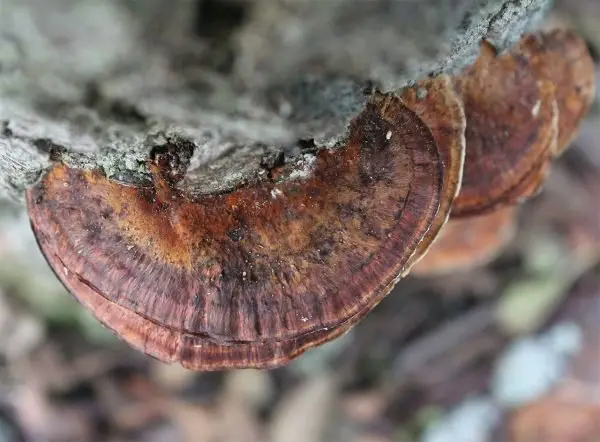Radiant polypore (Xanthoporia radiata)
- Division: Basidiomycota (Basidiomycetes)
- Subdivision: Agaricomycotina (Agaricomycetes)
- Class: Agaricomycetes (Agaricomycetes)
- Subclass: Incertae sedis (of uncertain position)
- Order: Hymenochaetales (Hymenochetes)
- Family: Hymenochaetaceae (Hymenochetes)
- Type: Xanthoporia radiata (radiant polypore)
- Radiant mushroom
- Polyporus radiatus
- Trametes radiata
- Inonotus radiatus
- Inodermus radiatus
- Polystictus radiata
- Microporus radiatus
- Mensularia radiata

Description
Fruit bodies are annual, in the form of sessile, widely adherent lateral caps of a semicircular shape and triangular section. Hat diameter up to 8 centimeters, thickness up to 3 centimeters. Hats are arranged in rows or tiled and often grow together. The edge of young caps is rounded, with age it becomes pointed, slightly sinuous and can be bent down. The upper surface of young mushrooms is velvety to slightly downy (but not hairy), yellowish or yellowish brown, later glabrous, with a silky sheen, uneven, radially wrinkled, sometimes warty, rusty brown or dark brown, with concentric stripes, overwintered specimens are black-brown, radially cracked. On fallen trunks, prostrate fruiting bodies can form.
The hymenophore is tubular, with angular pores of irregular shape (3-4 per mm), light, yellowish, later greyish brownish, darkens when touched. Spore powder is white or yellowish.
The flesh is rusty-brown, with zonal banding, soft and watery in young mushrooms, becoming dry, hard and fibrous with age.
Ecology and distribution
The radiant polypore grows on weakened live and dead trunks of black and gray alder (most often), as well as birch, aspen, linden and other deciduous trees. Can cause significant damage in parks. Causes white rot.
A widespread species in the northern temperate zone. Growing season from July to October, in mild climates all year round.
Edibility
Mushroom inedible

Similar species:
- Oak-loving inonotus (Inonotus dryophilus) lives on live oaks and some other broad-leaved trees. It has more massive, rounded fruiting bodies with a hard granular core at the base.
- The bristly tinder fungus (Inonotus hispidus) is distinguished by a larger size of fruiting bodies (up to 20-30 centimeters in diameter); its hosts are fruit and broad-leaved trees.
- Inonotus knotted (Inonotus nodulosus) has a less bright coloring and grows mainly on beech.
- The fox tinder fungus (Inonotus rheades) is distinguished by a hairy surface of the caps and a hard granular core inside the base of the fruiting body, occurs on live and dead aspens and causes yellow mixed rot.









